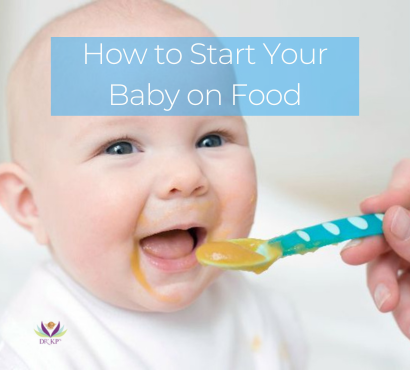Introducing solid foods to your baby is an exciting milestone but can also feel overwhelming for new parents. Knowing when to start, what foods to introduce, and how to do it safely is essential for your baby’s growth and development.
This guide covers everything you need to know about starting your baby on food, including recommended first foods, feeding tips, common mistakes to avoid, and answers to frequently asked questions.
When to Start Solid Foods?
The World Health Organization (WHO) and the American Academy of Pediatrics (AAP) recommend exclusively breastfeeding for the first 6 months of a baby’s life. However, solid foods can be introduced around 6 months of age while continuing breastfeeding or formula feeding.
Signs Your Baby is Ready for Solid Food
Your baby may be ready for solid foods if they:
✔️ Sit upright with support
✔️ Have good head and neck control
✔️ Show interest in food (watching others eat, reaching for food)
✔️ Lose the tongue-thrust reflex (stops pushing food out of the mouth)
✔️ Can close their lips around a spoon and swallow
⛔ If your baby does not show these signs, wait a little longer before introducing solids.
Best First Foods for Babies
When starting solids, it’s best to offer single-ingredient foods that are soft, easy to digest, and nutrient-dense.
1. Iron-Rich Foods
Iron is essential for a baby’s brain development. Good sources include:
✔️ Iron-fortified baby cereal (rice, oats, barley)
✔️ Mashed lentils or dal
✔️ Soft-cooked pureed chicken or fish
2. Fruits
Rich in vitamins, fiber, and natural sweetness:
✔️ Mashed banana
✔️ Pureed apple
✔️ Steamed and mashed pear
3. Vegetables
Provides essential nutrients and fiber:
✔️ Boiled and mashed carrot
✔️ Steamed and pureed sweet potato
✔️ Mashed pumpkin
4. Healthy Fats
Supports brain development:
✔️ Mashed avocado
✔️ Full-fat yogurt
✔️ Ghee (in small amounts)
5. Protein-Rich Foods
Helps in muscle growth:
✔️ Cooked and mashed egg yolk
✔️ Well-cooked, mashed moong dal
✔️ Soft cheese or paneer (in small amounts)
🔸 Tip: Introduce one food at a time and wait 3–5 days before introducing another to check for allergic reactions.
How to Start Feeding Your Baby?
1. Begin with a Small Quantity
- Start with 1–2 teaspoons of pureed food and gradually increase as your baby gets used to eating.
- Offer solids once a day, then increase to two meals per day by 7–8 months.
2. Maintain a Breastfeeding or Formula Routine
- Solids should not replace breast milk or formula in the early months.
- Continue breastfeeding or formula feeding alongside solid foods.
3. Use the Right Texture
- 6 months: Smooth purees (runny consistency)
- 7–8 months: Slightly thicker mashed foods
- 9–12 months: Soft finger foods (small pieces of cooked vegetables, fruits, or soft bread)
4. Avoid Force-Feeding
- Let your baby decide how much to eat.
- If they refuse food, try again later or offer a different texture.
5. Introduce a Variety of Foods
- Offering different flavors and textures helps prevent picky eating later.
Foods to Avoid for Babies Under 1 Year
🚫 Honey (risk of botulism)
🚫 Cow’s milk as a main drink (can cause digestive issues)
🚫 Salt and sugar (extra load on kidneys)
🚫 Whole nuts and hard foods (choking hazard)
🚫 Unpasteurized dairy products (risk of infections)
🚫 Juices and processed foods (high in sugar and low in nutrients)
Baby-Led Weaning vs. Spoon-Feeding
Baby-Led Weaning (BLW)
✔️ Allows the baby to self-feed soft finger foods
✔️ Encourages independence and hand-eye coordination
✔️ Can be messier but helps in developing chewing skills
Traditional Spoon-Feeding
✔️ Parents feed smooth purees using a spoon
✔️ Ensures baby gets enough nutrition
✔️ Easier to monitor food intake
🔹 Best Approach? A combination of both methods works well for many families.
Common Mistakes to Avoid
❌ Starting solids too early (before 4 months) or too late (after 7 months)
❌ Not offering a variety of foods
❌ Feeding only sweet foods (fruits) and avoiding vegetables
❌ Giving large food pieces that pose a choking risk
❌ Introducing multiple new foods at once
Tips for Making Mealtimes Fun and Stress-Free
🎨 Make food colorful – Babies are attracted to bright colors
🥄 Use baby-friendly spoons and bowls
🤗 Encourage self-feeding – Even if it’s messy, let them explore
🎵 Sing songs or talk during meals – Keeps them engaged
🕒 Set a routine – Feed at the same times daily for consistency
Starting your baby on solid foods is an important step in their development. Introducing a variety of nutritious, soft, and easy-to-digest foods while continuing breast milk or formula ensures your baby gets the best start in life.
Be patient, flexible, and observant of your baby’s cues. Over time, they will develop a healthy relationship with food, setting the foundation for a lifetime of good eating habits.
🎉 Enjoy this exciting journey of introducing solids to your little one!
FAQ
1. How do I know if my baby is allergic to a new food?
Watch for rashes, vomiting, diarrhea, swelling, or breathing difficulties within a few hours after eating. If you notice any of these, stop the food immediately and consult a pediatrician.
2. Can I give my baby water at 6 months?
Yes, but in small amounts (2-3 teaspoons at a time). Before 6 months, breast milk or formula provides all necessary hydration.
3. What if my baby refuses to eat solid food?
It’s normal for babies to be hesitant at first. Keep offering different foods, try varying textures, and be patient. Avoid force-feeding, as it can create a negative association with food.

